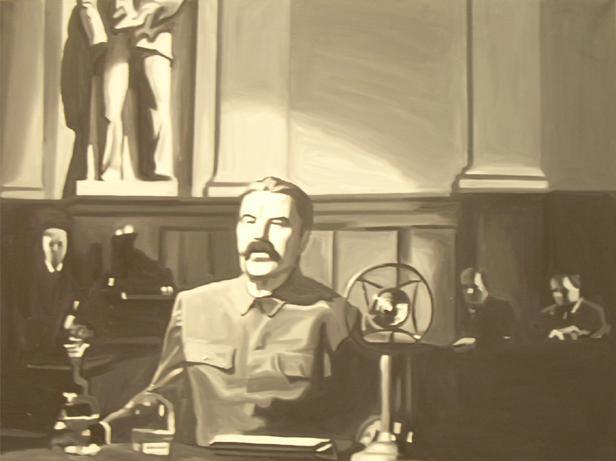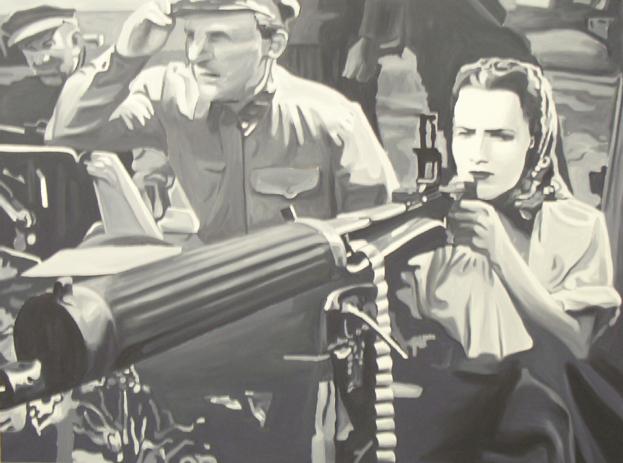Songs of Russia
Yevgeniy Fiks: The Song of Russia, 24 December 2005 – 24 January 2006, Gallery ArtStrelka Projects (Moscow)
Yevgeniy Fiks was born in Moscow and now teaches in New York, where he has been living for more than ten years. He presented his work in Moscow for the third time. Previously, he showed his work last year during the first Moscow Biennale at the group exhibition for émigré artists, “Post – Diasporas. Voyages and Missions”.
In December 2005, Fiks had a small solo exhibition that exhibited a work called “The Song of Russia” in a place that is very active and popular among progressive art-lovers and professionals yet not widely known among the ordinary public. Fiks’s project is worth mentioning as more than an individual attemptto get “back to the USSR”.
As both an artist and an attentive analytical observer, Fiks managed to capture in his project a major problem that plagues Russian society at the moment: the problem of the (Soviet) past. The traces of Soviet time and its heritage in art still have not yet become the part of the past.
The idea of the project is deceptively simple. Fiks exposes the fact that there was a short period of time in 1943-44, just on the eve of the Cold War, when the Soviet Union was regarded as a friend of the USA. Hollywood, as a symbol of bourgeois society, was given the task to make this friendship apparent to every ordinary American citizen. So Hollywood used the same crude propaganda tools to achieve the effect requested by the state. That is how the three films Fiks used in his work came into existence, “The Song of Russia,” “The North Star” (both by Metro–Goldwyn–Mayer), “Mission: Moscow” (Warner Brothers). (The first film gives the title to Fiks’s project.) In the era of McCarthyism, the creators of these films were black-listed. They did not have an opportunity to prove that these films were not their initiative, but rather he result of F.D. Roosevelt’s commission.
Some close-up shots from the films are reproduced in a number of oil paintings, as if the subjects had been transferred to the canvas. Each of them bears the trademark of the movie studio. So you have a number of black-and-white paintings simply hanging on the walls in one room, copying the parts of the film, which is shown in the adjacent room. In this way Fiks shows how art at worked in Soviet times. He focuses on propaganda art where the copy was more important and powerful than the original picture. What is fascinating about Fiks’s approach is the fact that the viewer has the film and the painted images in sight both at the same time, as part of a single “picture.”
This kind of reflection whose goal is to find correct, productive ways to rethink the past as the basis for today’s mentality in a non-ideological, analytical fashion, is rare in Moscow. The only evidence of it are the heated discussions around the heritage of Social Realism. For example, as part of the re-organization of the permanent exhibition at the State Tretyakov Gallery a colloquium was held in November 2005 which demonstrated all too clearly that even art professionals in Russia are not ready to face the facts about art in their country. The 20th century as a whole, and Social Realism in particular, still have not become the past.
Fiks experiences this distance geographically. Thus he is able to suggest a possible way of interpreting Soviet art practice without radical shouts. And his variant is perfect as in its form it is closer to historical assertion than conviction.
In the work itself the problem does not seem to be phrased as a heavy one, connotations become more essential than the art piece as it is. This aspect makes the work rather ‘light’ and elegant. Though some critics treat it as a painting that lacks the quality of the technique, it seems to be rather suitable for the number of problems it refers to. Is typical for the Soviet realism process of making paintings that the painting is based on photography (here it is a still from the movie) and that the message itself is more important than the way it is transmitted. So to have a kind of “absent technique” is to be close to the artificial reality the movies are trying to make natural, i.e. convincing.
To Russians there are a lot of funny details–decidedly Western stereotypes about our society – that can be seen vividly: the portrait of famous Russian poet A. Pushkin hangs on the wall as if it were an icon. In these details the artist’s irony is obvious, but his neutrality regarding the surface statement is saved.
The search for an image of Russia and how its history can be represented in art has become a tendency not only forartists who left their motherland but for those who remained as well. Among all the overly narrative or excessively decorative projects of 2005-2006 that were devoted to the search for the “current USSR”, “The Song of Russia” is a good example how we can reevaluate its knotty history.







